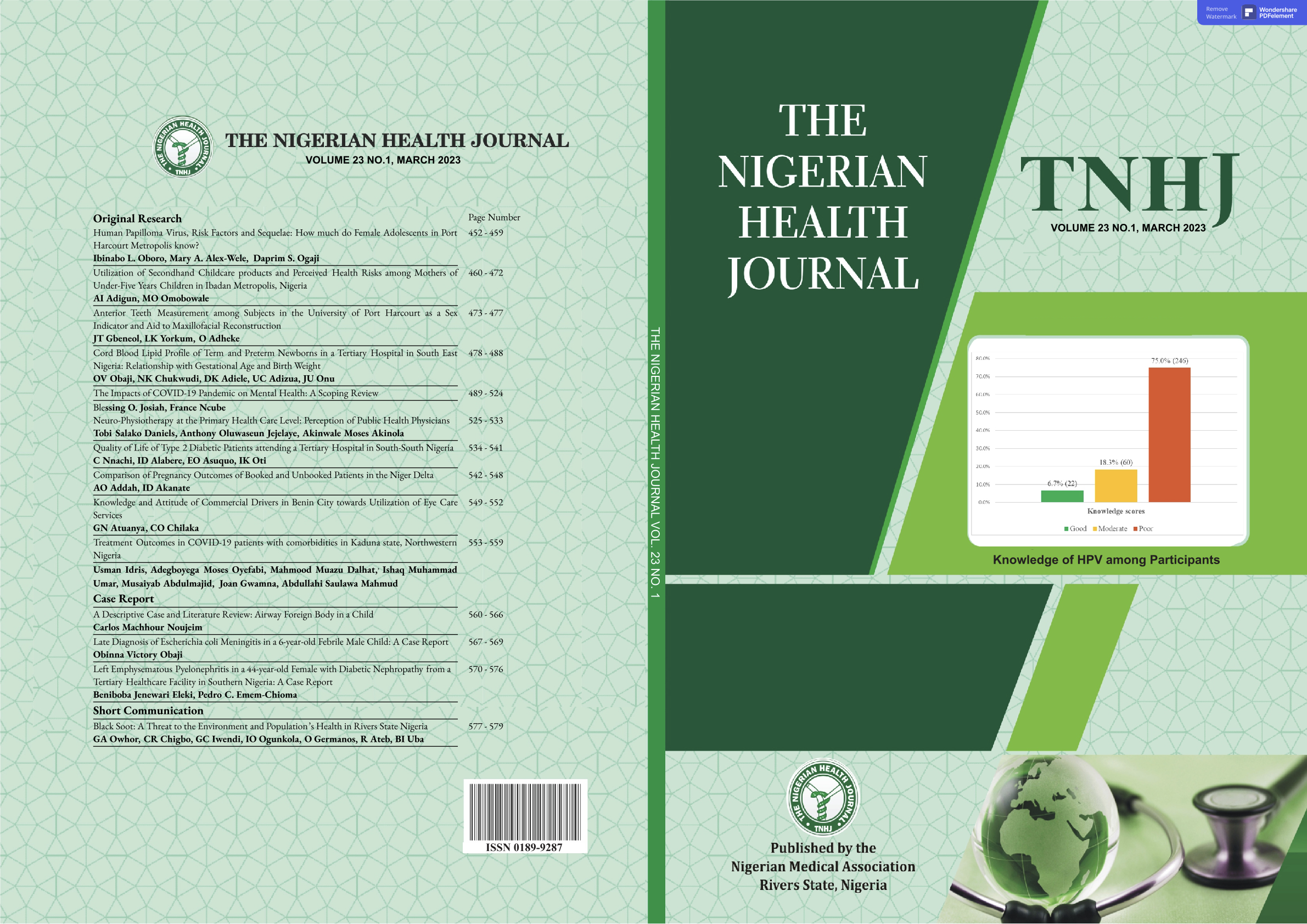Human Papilloma Virus, Risk Factors and Sequelae: How much do Female Adolescents in Port Harcourt Metropolis know?
Human Papilloma Virus Knowledge on Risk Factors and Sequelae Among Adolescents
DOI:
https://doi.org/10.60787/tnhj.v23i1.301Keywords:
Human Papillomavirus, cervical cancer, adolescents, Port HarcourtAbstract
Background: Human Papilloma virus (HPV) infection is the most common viral infection of the genital tract; is sexually transmitted with the highest rates observed in young women. This study assessed the level of knowledge of HPV and cervical cancer among adolescent girls in Port Harcourt metropolis, Nigeria.
Methodology: A cross-sectional survey among 328 in-school female secondary school students aged 9 - 19 years, selected via multi-stage sampling. Information on socio-demographics, knowledge of HPV and cervical cancer and sexual history were collected using a self-administered, semi-structured questionnaire. Data was analyzed using SPSS version 23 and Chi square test was used to establish associations.
Results: Only 38.2% and 30% had heard of cervical cancer and HPV respectively; the media being the most common source. Knowledge oftransmission, risk factors, sequelae and prevention of infection was poor (75%). About 20.2% were aware of the causal association between HPV infection and cervical cancer. Some (3.1%) were sexually exposed and practiced unprotected sexual intercourse. Median age at sexual debut was 11 years. Older and private school students (15-19years) had better knowledge
Conclusion: The level of knowledge of HPV, cervical cancer, their association and risk factors, among adolescent girls in Port Harcourt metropolis is poor. Some adolescents engage in sexual practices that put them at risk for HPV infection. Social media and upper primary and secondary school-based approach to HPV health promotion should be explored to provide detailed adolescent-friendly information to guide in prevention of HPV infection and cervical cancer
Downloads

Downloads
Published
Versions
- 2023-03-16 (2)
- 2023-03-11 (1)
How to Cite
Issue
Section
License
Copyright (c) 2023 Journal and Publisher

This work is licensed under a Creative Commons Attribution-NonCommercial-NoDerivatives 4.0 International License.
The Journal is owned, published and copyrighted by the Nigerian Medical Association, River state Branch. The copyright of papers published are vested in the journal and the publisher. In line with our open access policy and the Creative Commons Attribution License policy authors are allowed to share their work with an acknowledgement of the work's authorship and initial publication in this journal.
This is an open access journal which means that all content is freely available without charge to the user or his/her institution. Users are allowed to read, download, copy, distribute, print, search, or link to the full texts of the articles in this journal without asking prior permission from the publisher or the author.
The use of general descriptive names, trade names, trademarks, and so forth in this publication, even if not specifically identified, does not imply that these names are not protected by the relevant laws and regulations. While the advice and information in this journal are believed to be true and accurate on the date of its going to press, neither the authors, the editors, nor the publisher can accept any legal responsibility for any errors or omissions that may be made. The publisher makes no warranty, express or implied, with respect to the material contained herein.
TNHJ also supports open access archiving of articles published in the journal after three months of publication. Authors are permitted and encouraged to post their work online (e.g, in institutional repositories or on their website) within the stated period, as it can lead to productive exchanges, as well as earlier and greater citation of published work (See The Effect of Open Access). All requests for permission for open access archiving outside this period should be sent to the editor via email to editor@tnhjph.com.









